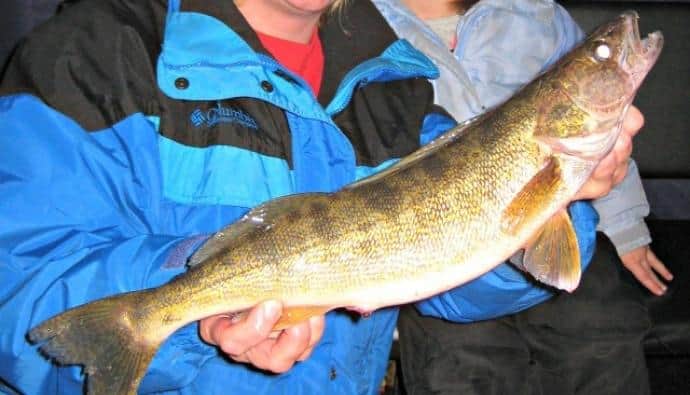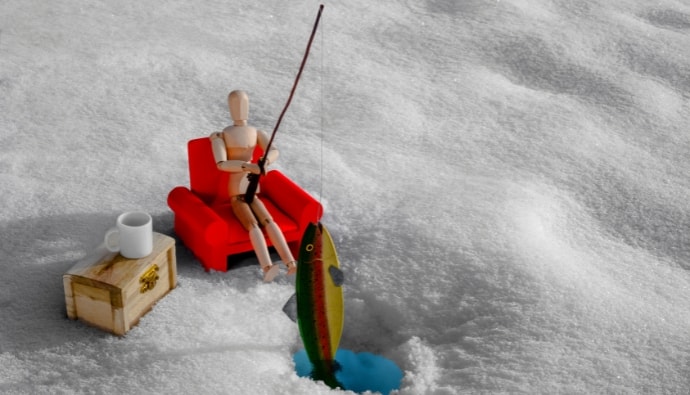The walleye is one of the most desired species for ice anglers. However, it is also one of the most unpredictable fish species. The reason for this is that a lot of fishermen do not understand the behavior of this fish species.
In this article, we will discuss all that you need to know about ice fishing for walleye. We will explain the simple steps to find them under ice, tips, and techniques for fishing them, as well as the best lures and baits to attract them.

Finding Walleyes Under the Ice
Before you proceed to cast your lures or bait, it is essential to find to locate the walleye under the ice. Once the walleye is located, you can set up your ice fishing shelter and then cast your lures in the right spot.
To find walleyes under the ice, it is important to understand their feeding pattern. Below are the steps to follow in order to find walleyes under the ice.
Find The Prey
Finding the prey is keep to finding the walleye under the ice. The walleyes can typically be found in areas where the prey species are located. This means that if the baitfish are schooling in the weeds, you are most likely to find the walleyes there.
Therefore, you need to know what is located under the ice in order to predict where the walleyes are going. This will help you to know when they are going shallower. It is important to note that walleye typically feed about an hour before dusk, continuing into the night.
It is, therefore, best to arrive at the fishing location during the day in order to start drilling holes for fishing later. At dusk, you will need to focus on following the movement of the prey, which is why drilling new holes at this time is not ideal.
Light
Another way to find walleyes on hard water is to follow the light. This is because walleye feeding is affected by light.
As a matter of fact, on overcast days, the period before dusk, as well as other conditions that affect lighting, use prompt walleye hunt. This means that at any point when the light is low, walleyes are going to move from the depths into shallow water in order to hunt.
During this period, they can be found around the edges of weed beds. Looking for shad, smelt, suckers, and other prey.
Structure
You also need to understand the structure when looking to locate walleye under the ice. It is important to note that walleye move from deeper columns of water to the shallower parts when looking for food.
Look out for points when targeting walleye, as they tend to target such structure. Also, look out for shallow areas that have a drop-off, as prey species typically gather there.
Map Out Your Locations
Now that we have discussed what to look out for on the water, we can highlight the best way to find walleye underwater. The first thing to do before leaving home is to map out your locations.
You want to do this before your trip in order to avoid encountering problems. Pick out about three or four locations, ensuring that they show the structural transitions in depth. This will help you to spot areas like the mid-lake humps and near-shore points.
Drill 10 to 15 Holes
Drilling multiple holes in a location will help you to track the movement of the walleyes faster. The standard number of holes per location is about 10 to 15.
Make sure to drill these holes in a zig-zag line or in a grid pattern. You can spread the holes across the ice in order to give you better access to the walleye underneath.
For effectiveness, it is best to spread the holes across the structure. Drill 5 holes along the deeper section, another five along the transition, and the last five along the shallow area of the water.
You can then jig the walleye fishing rod in each hole section for about five to ten minutes before finding fish.
Ice Fishing for Walleye – Tips & Techniques
Before we highlight useful tips and techniques for ice fishing for walleye, it is essential to understand the behavior of the fish species.
Walleye can be best described as a fish species that resembles a hybrid of perch and pike. They come in gold and olive color, have sharp teeth, and have a very healthy appetite.
Walleye are carnivores that feed on other fish. Some of the fish species that are part of a walleye’s diet are suckers, smelt, lake herring, and perch. Avid anglers take advantage of the feed patterns of walleyes to track them. The prey, habitat, structure, and light can be used to locate them underwater.
Walleyes are known to be highly migratory, moving from their summer feeding areas to spring spawning beds. However, they do not move around as much when the water starts to freeze.
Below are some tips for ice fishing walleyes.
Pound the Ground
Pounding the ground with your jig is one of the best ways to get a walleye to swallow your lure. When you pound the ground, there are two main actions that attract the fish.
The first one is that a cloud of sediment is created whenever you pound the ground. This gives the walleye the idea that a fish has disturbed the bottom, thereby prompting it to go after the prey species.
Another thing is that the pounding gives off a vibration that attracts the walleye as well.
Jig Aggressively
Jigging aggressively causes finicky walleye to pay attention to your lures, thereby enticing them to bite. It is vital to interchange aggressive jigging with a gentle presentation.
Lure The Walleye Up
Walleye do not take the jig every time that you present it to them. This is why it is necessary that switch things up by luring them up. Simply lift your lure a few feet higher, and the walleye will be prompted to give chase.
Sweeten Your Lure
Sweetening your lure gives it a nice scent that attracts bites from walleye.
Ice Fishing for Walleye Lures and Bait
Walleye are predators that go after smaller fish. As such, it is best to use lures and baits that mimic small fish ice fishing for them.
You can make use of lures such as lipless crankbaits, spoons, and jigs to great effect. The color of the lure that you should use is determined by the condition of the water. In clear water, it is best to use lures that have natural-looking colors in order to stand out.
Another property that your lure should have is to reflect light. This is why silver-colored baits are reliable. In the early part of the ice fishing season, walleye can be found in shallow water, with a low snow cover over the water.
During such a period, silver lures reflect light, thereby calling in the walleyes.
For stained water, it is best to go with lures that have bright colors. This is because bright colors provide visibility for your lures in the murky waters.
Natural colors often get lost in stained water as they blend with the water, making it difficult for the fish to spot them. Bright colors such as chartreuse, pink and yellow are best in stained water. The period with stained water is often characterized by low light conditions and heavy snow cover.
A two-pole approach works well in a shanty. To do this, drill two holes side by side. In the first hole, set up a rod with a slip bobber and live bait.
In the second hole, set up the other rod with a jig and a lure. The live bait rod will attract finicky fish, while the jigging rod will attract aggressive eaters.
Conclusion
Ice fishing is quite fulfilling when you know your way around it. Ice fishing for an aggressive fish like walleye is the dream of every sport fisherman.
To have a successful outing, it is important to understand the behavior of this fish species. Being fish eaters, you can locate a walleye by studying its prey. Lighting and structure should also be taken into consideration at all times.
Visit the fishing location with the right tools for drilling in order to avoid getting stranded. Also, use bright lures for stained water and more subtle ones for clear water. Be sure to have fun while fishing.


 Facebook
Facebook YouTube
YouTube








